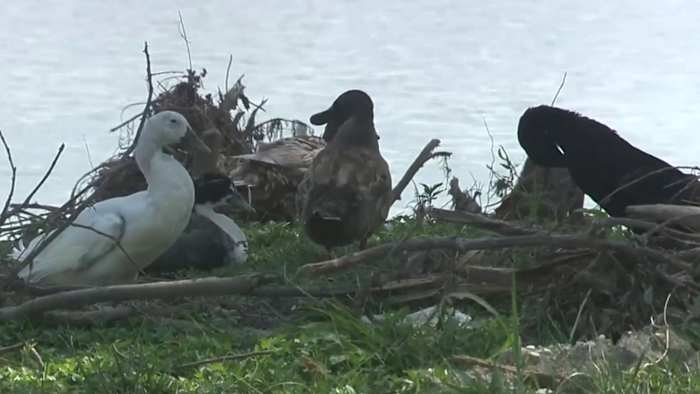KERR COUNTY, Texas – In the direct aftermath of the devastating Hill Country floods on July 4, something became noticeable: the silence.
Animals and insects were swept away, relocated or worst of all — eliminated.
Conservationist Azalia Rodriguez with the organization Defenders of Wildlife took KSAT’s Courtney Friedman on a walk along the Guadalupe River in Center Point, where they were able to survey the land and spot signs of healing nature.
“Nature is already starting to take back its place,” Rodriguez said.
Rodriguez represents the 18 counties that make up the Hill Country, an area that greatly contributes to Texas having the second-highest biodiversity in America.
“You’ll see some deer, you’ll see owls, opossums, you can even see armadillos out here,” she said, just to name a few. “There are lots of bird species, a lot of endangered species like the golden cheek warbler. For aquatic this is home to the Guadalupe darter, sunfish, bluegill, carp species, bass species.”
When Rodriguez saw the devastation after the flood, she was devastated. However, now she is back on the land she loves, seeing many species come back to their homes.
“When I parked the car today there was a red-shouldered hawk that flew into the tree,” Rodriguez said.
Wildlife slowly resurfacing
In the first minute of the walk, Rodriguez picked up a huge feather off the ground, saying, “This is a big deal. It’s probably either like a black vulture, maybe something that’s more of a raptor bird.”
Along the walk to the river, Rodriguez stopped to point out tiny frogs hopping, broken shells in the sand and even deer droppings.
“They definitely look like they’re fresh, and so again it just kind of shows the natural process that nature is starting to return in wildlife for coming back,” Rodriguez said. “They normally aren’t even this close to the river, but look at all this fresh vegetation, and this is what keeps them fed and hydrated.”
Rodriguez said other mammals have also been found in areas where they usually don’t go.
“Foxes and opossums and things like that. They’re trying to escape and then you end up having these misplaced species in other areas where you just really wouldn’t think for them to be,” she said. “But again, it just shows how resilient they are, because they will find a way to kind of maximize where they are.”
Finally reaching the river, fish darted near the surface.
“You’re seeing fish species, and with fish bring birds, insects, and they will bring other wildlife,” she said.
In the river’s eddies, the parts that curve out into the land, is where Rodriguez focuses on a very important endangered species.
“The Guadalupe fat mucket. It’s a muscle species,” Rodriguez said. “It’s one of those symbiotic relationships. It also interacts with fish and creates other kinds of food sources for other kinds of wildlife.”
These small mussels impact humans in a big way.
“One adult mussel can filter 8 to 15 gallons of water in just a single day, and so we need that. We need that clear water quality, that good filtration system,” Rodriguez said. “In our region, the majority of our drinking water is groundwater, so it’s important that we invest in those ecological services.”
When asked if she thinks there are any mussels left in the river, she said, “Right now it’s hard to say. There haven’t been any surveys done just because search and rescue right now is the priority.”
All they can do is wait and plan for the worst.
“There’s like state agencies that are doing propagation efforts,” she said. “We all work in coalitions together, and so one of the ways we do that is through the Hill Country Conservation Network, where it’s a network that’s built of nonprofits, state and federal agencies, universities and community members and landowners.”
However, species cannot be reintroduced until the habitat itself is healthy. With all the toxins wiped into the river during the flood, that is not yet the case.
“It’s going to take a while. Right now, groundwater authorities are testing the water quality every single day,” Rodriguez said. “Right now, it’s not very clear and it’s not very pristine and it’s going be a little bit until we’re able to introduce any species into this section of the river.”
‘Nature will always find a way’
The efforts and energy coming from the locals give Rodriguez hope.
“Community members want the involvement, and they go after it so well. There already have been community meetings about how we can move forward through conservation practices,” Rodriguez said.
Center Point flood survivor Angela Simons lives right across the street from the river and is starting to see the area begin to look healthier.
“Originally everything was gone, and now you’re starting to see a little bit of life again. Fresh stuff sprouting,” Simons said.
She said it makes her feel “hope that it’ll get better.”
Rodriguez shares that hope.
“Nature will always find a way to take itself back and heal itself,” she said.
Read also:
Copyright 2025 by KSAT – All rights reserved.

